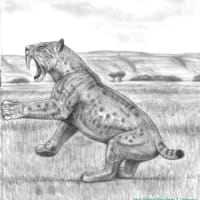Who's the king of proboscidea?
by the Saber Panther
There's been fairly a good amount of candidates accumulating nowadays, from giant mammoths to deinotheres that are each dubbed as the largest(heaviest) proboscidea ever appeared. Below listed are all such candidates especially notable for their astounding dimensions but the question here is not about the size. Which do you think would survive 'the royal rumble fight to the end scenario'...in other words, which in your opinion, should have been the toughest, strongest proboscidea ever lived? This is just for fun.
Now the sizes and morphological features of each species are partly revised based on the newly published research paper by A. Larramendi ('Shoulder height, body mass and shape of proboscideans' , 2015 Acta Palaeontologica Polonica) about proboscidean morphologies and sizes. Palaeoloxodon namadicus(along with the European mastodon, Mammut borsoni) is mentioned in the paper as being one of possible contenders for the title of the largest land mammal that ever appeared, but because of its somewhat elusive nature regarding the old measurement records and since its predicted dimensions are so outstanding that no other contenders could've standed a chance, I tentatively unlist the species just for the moment.
(Above mentioned paper is a scientific research that rigorously deals with shoulder heights, body masses and shapes of extant/extinct proboscideans and has nothing to do with this sort of vulgar entertainment)
Contestants(1 to 5 grades for each categories are made from no more than my guesswork)(SH=estimated shoulder height of grown males. BW=estimated body weight of grown males)
A) Deinotherium giganteum (Height 4, Length 4, Robustness 4, Mass 5, Agility 4*, Stability 4, Tusks as weaponry 1) SH 4m, BW 12t
*In spite of their gigantic sizes, Deinothere's slightly longer distal limb portions and locomotion mechanism seem to have been a bit different from that of other proboscideans, being probably more active, flexible and swifter(see the paper).
B) Deinotherium thraceiensis (Height 4, Length 4, Robustness 4, Mass 5, Agility 4, Stability 4, Tusks as weaponry 1) SH 4m, BW 13t
C) Elephas maximus asurus (Height 3, Length 2, Robustness 3*, Mass 2, agility 3, Stability 3, Tusks as weaponry 2) SH 3.5m, BW 7t
*According to the above paper, E.maximus is not distinctively heavier(proportionally speaking) than L.africana of the same shoulder height, as opposed to the previous understanding. Extant E.maximus and L.africana are probably the slimmest of all proboscideans except for E.recki. Many of older, more archaic species tended to have more heavily built limbs and a longer, wider torso.
D) Elephas recki (Height 5, Length 3, Robustness 2, Mass 4, Agility 1, Stability 2, Tusks as weaponry 2) SH 4.3m, BW 12t
E) Loxodonta africana (Height 3, Length 3, Robustness 3, Mass 2, agility 3, Stability 3, Tusks as weaponry 2) SH 3.3m, BW 6t
F) Mammut americanum (Height 2, Length 3, Robustness 5, Mass 3*, Agility 4, Stability 5, Tusks as weaponry 3) SH 2.5m, BW 7.5t
*Relatively low estimated weight figures for the American Mastodon that one often comes across in various sources may be due to insufficient allometric weight calculation methods(see the paper). The weight of this animal couldn't be about the same as in extant elephants of the similar height, on account of their longer, wider torso and significantly more heavy-set bone structures. Mastodons in fact, were the most robust of all proboscideans in history. The phylogenetically closer relative, Mammut borsoni that's listed below was considerably taller, longer, overall larger still.
G) Mammut borsoni (Height 4, Length 5, Robustness 5, Mass 5, Agility 2, Stability 5, Tusks as weaponry 5) SH >4m, BW >15t
H) Mammuthus columbi (Height 4, Length 3, Robustness 3, Mass 4, Agility 2, Stability 3, Tusks as weaponry 4) SH 4m, BW 11t
I) Mammuthus meridionalis (Height 4, Length 3, Robustness 4, Mass 4, Agility 2, Stability 3, Tusks as weaponry 4) SH 3.9m, BW 10t
J) Mammuthus trogontherii (Height 5, Length 4, Robustness 3, Mass 5, Agility 1, Stability 3, Tusks as weaponry 4) SH 4.3m, BW 13t
K) Notiomastodon platensis (Height 2, Length 3, Robustness 4, Mass 1, Agility 5, Stability 5, Tusks as weaponry 3) SH 2,6m, BW 5t
L) Palaeoloxodon antiquus (Height 4, Length 4, Robustness 4, Mass 5*, Agility 1, Stability 3, Tusks as weaponry 5) SH >4m, BW >13t
*It is remarkable that even a huge 'Montreuil specimen' that's estimated to have been over 4m tall and up to 15t in body mass can be treated as one of average or slightly larger sized individuals(size group 1~2) among the particular population of this species(see the paper).
M) Stegodon zdanskyi (Height 4, Length 4, Robustness 5, Mass 5, Agility 3, Stability 5, Tusks as weaponry 4) SH 3.9m, BW 13t
N) Stegotetrabelodon syrticus (Height 4, Length 3, Robustness 4, Mass 4, Agility 3, Stability 4, Tusks as weaponry 3) SH 4m, BW 12t




















※コメント投稿者のブログIDはブログ作成者のみに通知されます